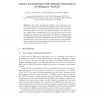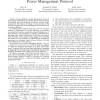67 search results - page 12 / 14 » Randomized protocols for asynchronous consensus |
89
Voted
WDAG
1992
Springer
15 years 4 months ago
1992
Springer
Abstract. The Choice Coordination Problem with k alternatives (kCCP) was introduced by Rabin in 1982 [Rab82]. The goal is to design a wait-free protocol for n asynchronous processe...
104
Voted
DSN
2002
IEEE
15 years 5 months ago
2002
IEEE
This paper describes a Secure INtrusion-Tolerant Replication Architecture1 (SINTRA) for coordination in asynchronous networks subject to Byzantine faults. SINTRA supplies a number...
CORR
2011
Springer
14 years 7 months ago
2011
Springer
Herman’s algorithm is a synchronous randomized protocol for achieving self-stabilization in a token ring consisting of N processes. The interaction of tokens makes the dynamics o...
100
click to vote
ICNP
2006
IEEE
15 years 6 months ago
2006
IEEE
— Energy efficiency is widely understood to be one of the dominant considerations for Wireless Sensor Networks. Based on historical data and technology trends, the receiver ener...
128
click to vote
ISTCS
1992
Springer
15 years 3 months ago
1992
Springer
Concurrent Time-stamp Systems (ctss) allow processes to temporally order concurrent events in an asynchronous shared memorysystem, a powerful tool for concurrency control, serving...


